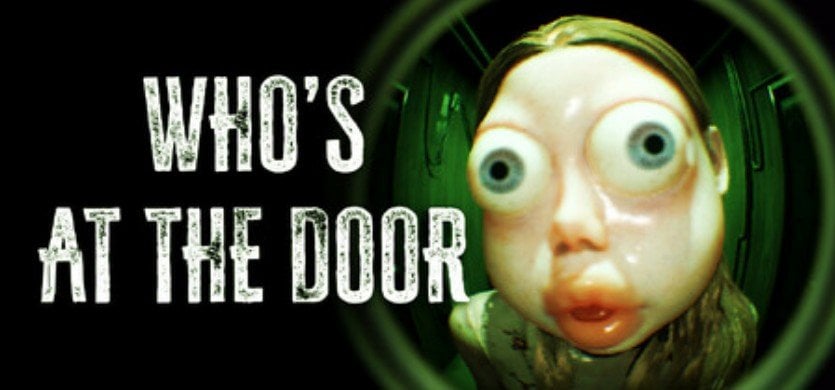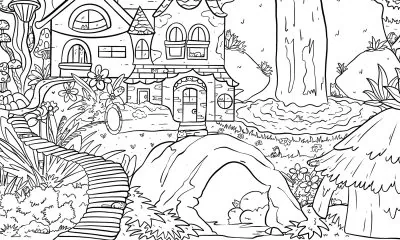Reviews
Who’s at the Door? Review (PC)

I’m struggling to separate fact from fiction, friendly neighbors from unkempt strangers, medicinal remedies from hallucinogenic pills — and I think they know, too. I’m midway through an eight-day binge of routine peeping and pill popping, carefully alternating between two different jobs. The first job is a simple one: collect pieces of a broken doll to help shed light on the situation. The second job, however, is a little more perplexing: identify visitors through a peephole in the door, and figure out whether they’re friendly, and if they’re willing to remediate the side effects of psychosis, or if they’re of another purpose. If their intentions are just, I can open the door. And if they’re not, then I have one simple goal: take the pills, and shun whatever looms beyond the doorway. The issue is, I’m unable to tell who’s who or what’s what. Curse this brain of mine.
Who’s at the Door? takes its inspiration from The Exit 8, yet another anomaly-centric object finding game that minces hallucinatory imagery with Backrooms-like behavioral traits. Here, however, you aren’t stuck in the underbelly of a Japanese metro station; rather, a relatively small home—a location in which you don’t necessarily have the luxury of bathing in simple homely comforts, but with an ultimatum of sorts. The question you must answer here, then, is a bleak one: who’s at the door, and what do they want? A simple question, admittedly, yet one that also carries a great deal of weight under the circumstances. Care to hear more about said circumstances? Then let’s knock.
Knock, Knock

Who’s at the Door? centers its proposal around a protagonist who, like many other cliché torchbearers in the survival-horror world, suffers from memory loss—a condition that, at least at the beginning of your journey through the corridors of a small home, has left the protagonist with a rather unfortunate fate. While not a great deal is known about the character, it does become awfully clear shortly after filling their boots that things, usually those on the adjacent side of the doorframe, aren’t always friendly. But there’s the catch: some folk possess the medicine that can aid your ongoing psychological problems, and some mean only to shove you deeper into a perpetual state of fear and despair. Therein lies the purpose of your time: to decipher who’s willing to help, and who’s willing to thwart your recovery.
The game unravels a lot like your typical scrapbook of episodic horrors, with each portion of the journey presenting you with a choice of some kind. If you manage to evade the scope of a potential anomaly, then you can take a dose of your medicine and teeter just that little bit closer towards recovery. If, however, you fail to identify an authentic visitor, then naturally, you will begin to feel the weight of your wrongdoing, with the world and your hallucinatory tendencies gradually becoming more apparent and even a bit, shall we say, sinister. The ultimate goal here, then, is to make enough correct decisions for a whopping eight days in order to capture the silver lining on the far end of the corridor.
I Spy With My Little Eye…

Although Who’s at the Door? is still short of a whole host of “anomalies” and other features, the current version of the game does sport a sturdy design with just enough jump scares and events to keep you on tenterhooks for that next big update. There’s still a bit missing from the pot, with only twenty hallucinations currently present per session, and a rather noticeable chunk of collectibles and story beats also being lost to the full-fledged version of the game. Yet, even without the full breadth of the whole pie, Who’s at the Door?” still manages to present a striking composition that feels both unique and oddly immersive. And while you could quite easily argue that it takes a leaf or two out of The Exit 8’s book, the fact is, it still adds its own twist to the blueprint, substituting anomalies and paranormal fiction with hallucinatory notions.
I’ll stand by my word and say this: Who’s at the Door? is a very, very creepy game. I’m not sure if it’s the disoriented ambience, or even just the way it presents itself. But it does something right, and it helps, too, that it paves the way for some compelling frights and well-orchestrated jump scares over the course of a sporadic affair between reality and the human psyche. The fact that it’s currently due to poke the fire with even more hallucinations and intertwining endings in the near future gives us all the more reason to keep the latch off the door too, truly.
Verdict

Who’s at the Door? adds an extra layer to the cult-like Exit 8 formula with an innovative and effective hallucinatory butterfly effect design that comes across as both intuitive and engaging. The demo, while still without the breadth of the catalog and a full pocket of endings and integrated features to sift through, luckily provides a fantastic introduction to the thriller, with a substantial amount of “anomalies” to collect, and not to mention a 20/20 glimpse through the spy hole of a potentially terrifying cult classic in the making. Maybe I’m being overly optimistic about this, or maybe I’m just showering it with endless praise for the sake of creating a reminder for myself that it’s a venture that’ll be worth returning to in the future. Either way, the fact is, I’m super excited to see how it’ll all pan out over the forthcoming season.
While you aren’t exactly likely to struggle to unearth your own share of anomaly-centric object finding games on the current market, you might find it somewhat difficult to find one that stands out as a genuine pioneer in the aforementioned field. The Exit 8 it most certainly is not, but a worthy love letter to the genre-defining staple, however, it is — and then some. And so, if you’re looking for something that lingers on the same lines, then you should definitely consider inviting this stranger in for a couple of jabs and a quick splash of coffee.
Who’s at the Door? Review (PC)
Stranger Danger
Who’s at the Door? takes the beloved Exit 8 formula for a spin with its own concoction of nightmarish hallucinations, pungently bleak scenery, and disturbingly memorable characters. It’s the making of a solid anomaly-like sequence, and if the benchmark is to be anywhere at the time of writing, it might as well be floating along the same lines as SKONEC Entertainment’s IP.













